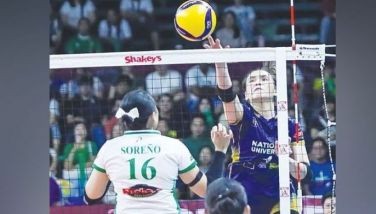Stunning horror drama set in martial law years
MANILA, Philippines - By now, the dreary subject of martial law atrocities and the arrest of dissenters has begun to diminish in interest to many viewers as prison dramas, both local and foreign, serious and exploitative, have become common. The entry to the current Cinema One Originals, the stunning Ka Oryang, defies this trend and effectively takes the audience face to face with military abuse and terror.
The film will stir painful, haunting memories of those dark days for a long time, and the screening now is timely as there has been of late, revival of the issues demonizing the Marcos dictatorship, from the rigging of the presidential election (allegedly repeated more glaringly and carelessly in the contest between Arroyo and FPJ, who has been said to be the real winner in 2004) and the use of the Armed Forces to prop up an illegitimate government, to the heated debate on whether the remains of former President Marcos should be buried at the heroes’ cemetery. Then the current President is taking a firm stand against any form of corruption and tyranny, his family having shared the suffering of his father Ninoy Aquino, the regime’s top political prisoner.
Imprisonment, torment, murder by an unidentified assailant. These are the highlights of a movie that reminds older viewers of the evil that happened in the early ’70s and opens the eyes of the new generation to the unbelievable punishment of political detainees. When the movie begins, we hear the communist anthem The Internationale at a rally during what has come to be known as the First Quarter Storm. Mao-adoring, young demonstrators denounce the dictatorship, and next, we see the protesters on the next level of their struggle in the jungle as idealistic fighters. Youthful passion, love of country and quest for freedom has driven these people to the hills. Next act: The guerillas have fallen and are now at the mercy of men who show no mercy.
The dramatic moments work and the torture scenes will make the viewers cringe, a feat attributable chiefly to the cast led by the consistently remarkable Alessandra de Rossi in the title role. Ka Oryang is her character’s underground alias borrowed from a real historical figure, the brave Gregoria de Jesus.
Female Amazons-later-captives are Angeli Bayani, Kalilia Aguilos and Marife Necesito all delivering compelling performances. In the male cast are two former Urian acting winners: Joem Bascon, looking inappropriately well-fed, as comrade-in-arms, and Emilio Garcia effective as a monster in uniform and devil incarnate. Che Ramos, a praiseworthy actress in her other indie efforts, makes a brief but creditable appearance.
If women dominate the picture, the director herself is a woman, Sari Raissa Lluch Dalena, record winner of three Gawad Urian trophies for Best Short Films Yuta: The Earth Art (with Hesumaria Sescon), Asong Simbahan and Mumunting Krus and daughter of top artists Danny Dalena and Julie Lluch. Parental mention is in order since one of the strongest points of Ka Oryang is its visual quality. Sari’s father is a titan in the art scene known for his large social-realist canvases. The mother is an accomplished sculptor, arguably the only Filipino woman to have carved a name in her field an original and prolific artist.
This fact indicates that the director’s eye for composition, color and detail is in her genes, whether the shot is indoors or out, up close or far, and it’s evident in every frame created by Neil Daza whose splendid camerawork enjoys additional footage from Sari’s sister Kiri, the second unit director of photography. Like comas in a sentence, the camera depicts tight shots of Amable Quiambao as Nanay Rizal, the conscience of the new militants and spiritual progeny of Melchora Aquino, Gabriela Silang and the original Ka Oryang herself. With her silver hair framing a beautiful face, Quiambao is a portrait of quiet dignity and wisdom. The horror moments of torture in dark, shadowy interiors are stark and intense, all the more terrifying and sinister because they are intimate and tightly shot.
A brilliant interlude follows these harrowing moments well-preserved newsreel footage shows President Marcos and a spectacularly lovely First Lady Imelda daughters Imee and Irene in tow meeting Deng Xiao Ping and then Chairman Mao himself in Beijing, the women taking turns planting a buss at the aging and visibly confused communist icon.
As the eyes and heart behind Ka Oryang, Sari is credited as director and producer as well as writer of story and screenplay (her real-life partner Keith Sicat is film editor). Ostensibly adding weight to the research and story is “script consultant” Ricky Lee, militant writer during the pre- and early martial law years, who himself was arrested and has admitted to having experienced psychological torture. With this work, Sari joins veteran director Joel Lamangan as advocate of committed cinema. In one film after another, Lamangan, another ex-detainee in the infamous era, has almost single-handedly continued to expose political evils during the Marcos era, as in last year’s Sigwa. Now Dalena and Lamangan raise the torch, call attention to the cause of political detainees and warn us about unchecked military evil. Dalena brings a fresh perspective to the genre, zeroing in on what happens to women detainees.
At its most basic, Ka Oryang is a dramatization of the shocking plight of political prisoners especially women who are cruelly injured, hog-tied, humiliated, nearly strangled and raped. More broadly, it reawakens us to political evil that, having happened before, may happen again. Forgetting would be a tragedy and a folly. The bottomline is: Keep your eyes open, never let your guard down, and stay vigilant.
- Latest
- Trending
































